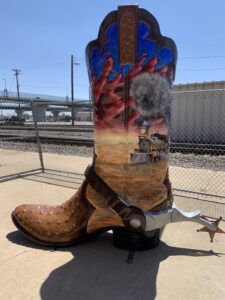Historical Cheyenne, Wyoming
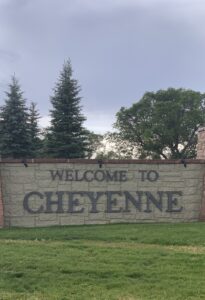
Ask anyone today what they think of when they think about Cheyenne, Wyoming. Most will probably say “Frontier Days”, or, “rodeos”.
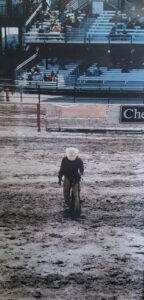
It is, after all, home to the Daddy of ’em All as far as rodeos go. I have been to both, and it is, hands down, the best rodeo I have ever been to!
Cheyenne, to this day, has the reputation of a wild west town. While that is definitely a large part of the history of Cheyenne, there was also a time when Cheyenne was home to some really wealthy people and run by the rich. Though short lived, a lot happened during this time, and many buildings were constructed. To this day, many of these buildings not only exist, but some are still in use.
It is the history of the railroad, the military, the rich cattle barons and the lawlessness of the wild west that have come together to create Cheyenne, Wyoming.
Take a walk through downtown Cheyenne, and a lot of this history can still be seen today.
The Depot
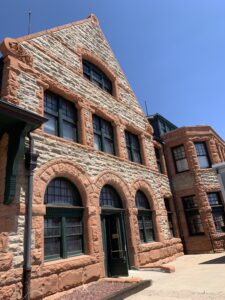
Cheyenne began as a headquarter for the Union Pacific Railroad in 1867. Originally, it was called Crow Creek Crossing. and served as the division point for the railroad. Initially, the depot was nothing more than just a small wooden structure, which sat on the same site that the Union Pacific Depot sits on today. By the 1880’s, money had come to Cheyenne, thanks to the cattle barons, and a new depot was constructed. This depot replaced the wooden structure, and was made of two types of quarry stone (from the same quarry) – which was practically unheard of.
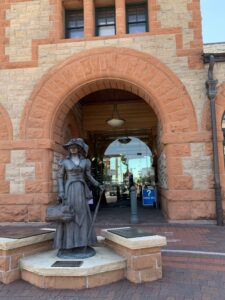
A tunnel was built into the depot. This would allow the families of the rich cattle barons a place to wait for the train, and keep them out of the weather.
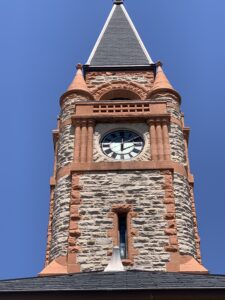
In 1890, a clock tower was added, and to this day, it only loses about a minute a month. A restaurant was added at the end of the depot in 1922 –
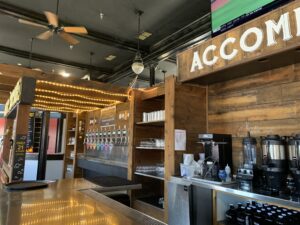
and today it remains a brew pub.
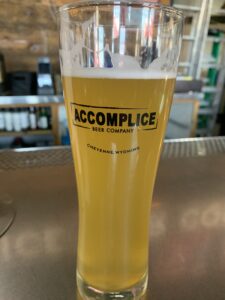
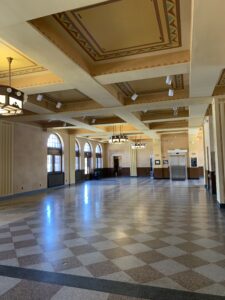
The lobby was also redone in the 1920’s, and by 2004, it was added as a National Historic Landmark.
The Plains Hotel
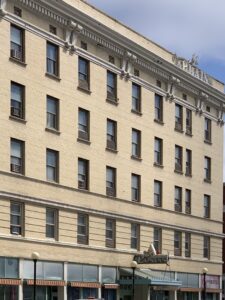
I have a few favorite buildings in historic Cheyenne, and the Plains Hotel is one of them.
In 1868, Francis E. Warren came to town. Though he had basically no money to his name, he was able to make a living just by running an honest business and being friendly. He went on to become Wyoming’s first Senator, and held that seat for the next 37 years! During his time, he also went on to establish 9 buildings in Cheyenne – 7 of which are still there today. The Plains Hotel is one of them.
In 1909 it was decided that the town needed a new hotel. The only one the town had at the time, was the Inter-Ocean, and it had become more of a watering hole of sorts, than an actual hotel. By 1910, construction had started, and by 1911, it was complete – with a price tag of around $250,000. – complete with furnishings. It was the first hotel to have a telephone in every room.
Today, the hotel is still open to guests. A lot of the original work can still be seen – the tile and mahogany floors, the staircase leading from the lobby, and the Mezzanine level which, at the time, served as a place for an orchestra that entertained guests. The rooms are decorated in western art and showcase pictures of what the hotel and town looked like back in the day. It is still every bit as elegant today as it was back then.
I think my favorite thing about the Plains Hotel though, is the story that haunts it…
A couple had checked into the hotel shortly after it had opened. They were a newly married couple. The husband had gone downstairs to have a drink, but instead had met a prostitute. His wife had followed him downstairs, and saw him leave the bar with the prostitute. She followed them up to her fourth floor room, where, Rosie (the bride) shot them both and killed them. She returned to her own room, and killed herself.
They say the ghosts of Rosie, her husband and the prostitute, still roam the halls of the Plains Hotel today. They have been seen and heard by staff and guests alike.
Capitol Theater / Paramount Theater
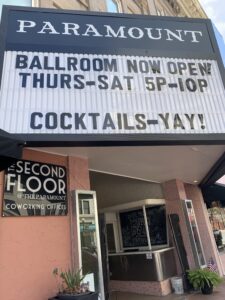
In 1904 the Capitol Theater was built. At the time, it was the most elegant theater around, and was used strictly for theatrics. It was very successful for the next ten years. In 1915 however, fire struck and burned a lot of the theater. It was renovated and continued to run as the Capitol Theater, until 1930 when it would be renamed the Paramount Theater. However, in 1981, another fire broke out – this time caused by a burglar trying to conceal his crime.
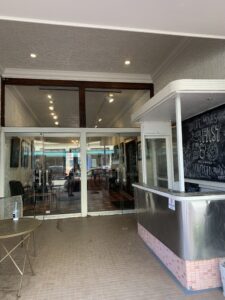
The only original items that remain are the projection booth and the ticket booth.
Rocky Mountain Bell Telephone
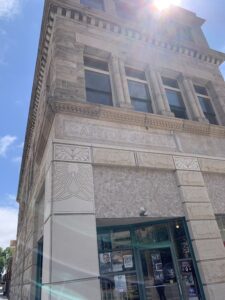
The Rocky Mountain Bell Telephone building was built in 1906. Although it serves as office buildings today, the story that goes with it, is something everyone has probably heard about (I say “probably”, because, if you grew up only in the age of cell phones, you may not have heard!)…
Wyoming had its first long distance telephone call which took place between Cheyenne and Laramie (45 miles away). Within 5 years, there were so many subscribers to the Bell Telephone System, that a local printer was hired to print up a phone directory. While printing the directory, he ran out of white paper. All he had was yellow paper, so he completed printing on the yellow paper….thus was the beginning of the yellow pages! Before long, the Yellow Pages were being used – nationwide!
Who would’ve thought, that in just over a hundred years, we would be able to fit not only the yellow pages, but a world of other useful (and useless) information, in the palm of our hands….gone are the days of not only the Yellow Pages, but talking to an Operator – now we just have to “ask Siri”…
St. Mark’s Church of Cheyenne
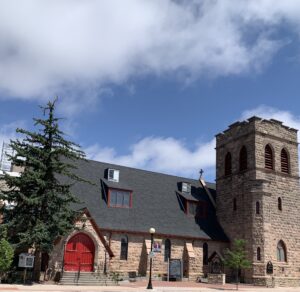
Back in the day, Cheyenne was home to 5 churches. Still here today, St. Mark’s, is known as the Pioneer Church of Wyoming. It was the first church built in Wyoming, back in 1868. The bell tower, however, took decades to complete, and was not actually completed until 1927. Rumor has it, the reason for the delay in completion of the tower is because the masons who were hired to construct it, kept disappearing. In fact, there are a few stories associated with St. Mark’s that have led people to believe the church is actually haunted.
One of these stories, is that of one of the masons who was actually on the construction crew for the bell tower. A man who claims to have been working on the tower with other masons, says that one day while he was working, one of the other masons fell to his death. In a panic, the mans body was placed inside of the tower and concealed in cement. Supposedly the man responsible for placing the body in the tower, confessed to his crime in the 1960’s, just prior to his own death. The church still has the mans written confession to this day. People say you can sometimes hear voices in the walls of the church, as well as organ pipes – even though the organ is not being played. As recent as the 1980’s, a local couple was in the tower, and claim they witnessed liquid coming from the walls, balls of light shooting out over the cemetery, and a voice telling them to “get out”. The names of the two people were never released, however.
A church register shows some of the events that originally took place in St. Mark’s. Among these events are burials of cavalrymen killed by Indians, weddings for Governors, burial services for the wife and children of General Pershing (General Pershing’s wife, happened to be the daughter of Senator Frances E. Warren), as well as a place of worship for President Franklin D. Roosevelt. It was also where Tom Horn would be given Last Rights and prayers before his hanging in 1903.
The Capitol Building
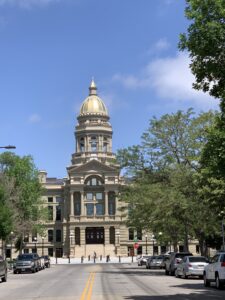
Groundbreaking for the Capitol Building began in 1887, and by the end of 1888, the first section of the building was complete. Francis E. Warren, who was Governor at the time, commissioned to raise almost $140,000. for the building, which turned out to be more than enough money.
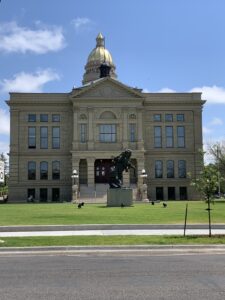
Within a couple of years, two extensions had been built onto the building. It was during this time that Wyoming had become the 44th state. The Wyoming State Capitol Building is one of only several that were constructed during this time.
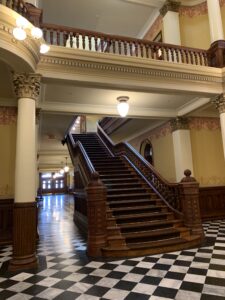
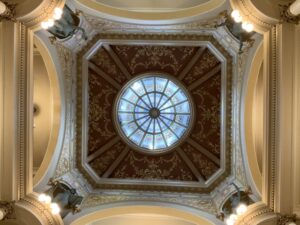
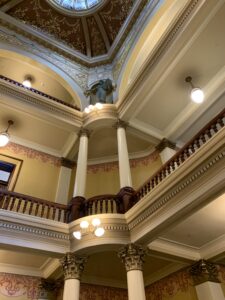
The construction of the building was influenced by Thomas Jefferson’s Virginia State Capitol Building. The Wyoming State Capitol played a major role in hosting conventions for Women’s Suffrage, and by 1890, 90% of Wyoming women were voting. When Wyoming became the 44th state, it did so as the very first state to achieve suffrage.
The Idleman Mansion
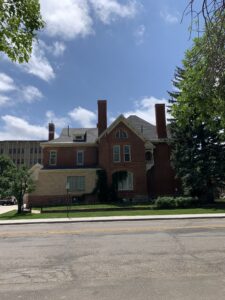
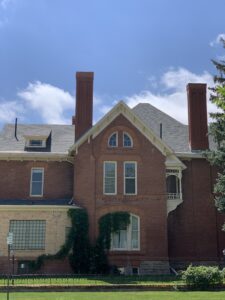
The Idleman Mansion is the only cattle baron mansion still standing in Cheyenne today. It is situated across from the Capitol Building on what was once known as Cattle Baron Row. Built in 1883, it was home to whiskey and beer distributor, Max Idleman. During this time, the mansions third floor served as one huge ballroom. Today, the mansion is actually a mortuary. All of the interior though is still just as it was back in the day. The only difference is in the exterior – they have added a chapel as well as a garage for the limos.
Governor’s Mansion
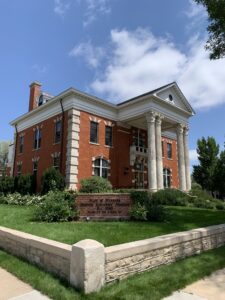
In 1904 the first Governor’s Mansion was built in Cheyenne. Over the years, from 1905-1976, 19 families would come to live here. The most famous resident, was probably that of Nellie Taylor Ross. She was the first female governor and served from 1925-1927. She was well liked, but claimed she more than likely lost re-election due to the fact that she did not campaign for herself. In 1933 she became director of the U.S. Mint, and in 1977 she passed away at the age of 101.
The cost of the mansion back in 1904, for construction, furnishings and landscape, was just over $33,000. In 2004, the mansion was restored. Each room represents a particular time in the history of the mansion. The basement is a fall out shelter.
County Courthouse
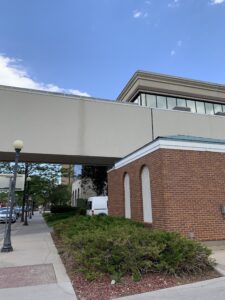
Today, the county courthouse sits along Pioneer Ave in Cheyenne, where, back in 1903, history was made.
It is the site where the legendary Tom Horn was hung for the murder of 14 year old Willie Nickell. Though Horn was already suspected of killing a few dozen men – mostly cattle rustlers, he denied killing Willie Nickell. He claims he was tricked by the marshall into saying that he shot Willie. Although Horn was intoxicated when he made the statement to the marshall, a court stenographer was listening in from the adjoining room, recording what was being said. Horn was brought to trial, and found guilty. He was the last man to be legally hung in Cheyenne, in 1903 – a day before his 43rd birthday.
The Dineen Garage
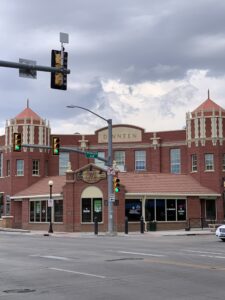
William Dineen was born in 1861 and came to Cheyenne in 1879. He worked in the grocery business as well as the livery business, before turning his attention to the automotive business. He built his brick garage, complete with a special hydraulic lift, which only used 50 gallons of water, to lift cars up to the second floor. The lift is still in operation today! The automobiles that Dineen sold at his garage, were shipped in on the railroad, stacked up on end to fit as many cars as possible. He sold automobiles such as REO, Essex, Hudson, Edsels, Desoto, Lincoln, Mercury and Buick.
The Tivoli
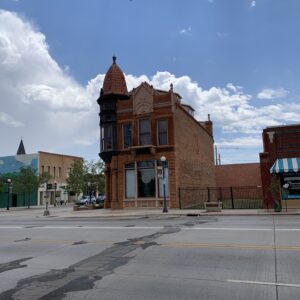
The Tivoli is probably my favorite building in all of Cheyenne! The original floor of the Tivoli building was built in 1883. In 1892, two additional floors were built. It was a popular drinking spot and cowboy hangout during Frontier Days. In 1919, the Tivoli was purchased by a man named Sam Marchik. During Prohibition, the Tivoli was turned into a clothing store, while the basement became a Speakeasy. Prostitution was legal in Wyoming, and the second floor became a Brothel. When Prohibition ended, the Tivoli was once again turned into a drinking establishment. It remained a drinking establishment until the 1960’s when it became vacant. The Marchik family owned the Tivoli building until later in the 1970’s. In 1978 it was added to the National Register of Historic Places. The Chamber of Commerce purchased the building, and over the years it was home to several businesses, including the Tivoli Coffee Shop. It was later purchased in 2006 by Matt Mead who was an attorney that would later become elected Governor of Wyoming. It served as his campaign headquarters, and in 2012 was once again returned to a drinking establishment. Today it is used as a Law Office.
The Streets of Cheyenne
Cheyenne didn’t get the reputation as a wild west town for no reason. It was a rough town where people like Wild Bill Hickcock, Wyatt Earp, Charlie Basset, Tom Horn, The Gunny Sack Gang and the Vigilantes walked the streets. It was home to over 90 saloons and gambling halls, as well as Brothels and tents that housed over 400 prostitutes. While mayhem and murder were no strangers to the streets of Cheyenne, it was also home to some of the richest and wealthiest cattle barons around. All you have to do is simply walk through the streets of downtown and you can see history come alive in the buildings that remain and on the plaques that are mounted around the town. I only barely touched on the history of this town. There is so much more to it, including the history of the military base here. Cheyenne is a town worth visiting, not only for Frontier Days and Rodeos (which are a lot of fun by the way), but for the wealth of history that this town holds. I mean, where else will you find a town where prostitution was legal, but it was illegal to take a photo of a rabbit if it was between January and April?
